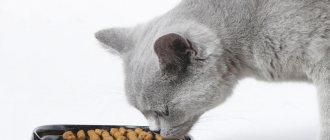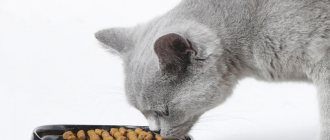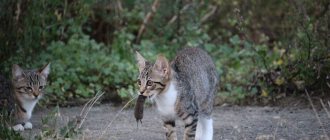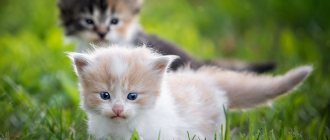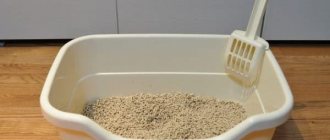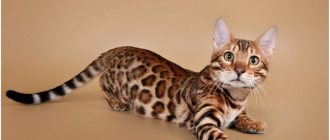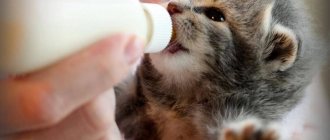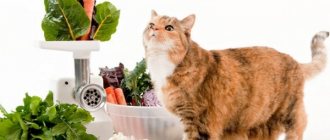Features of development of kittens at 4 months
By the age of four months, the growth of kittens gradually slows down, but full formation has not yet occurred. Muscles continue to develop, and the weight approaches that of an adult animal.
Feeding during this period should correspond to the developmental characteristics of kittens at 4 months:
- Continued active exploration of the environment. Despite the fact that babies are becoming more and more similar to their adult counterparts, pampering, playfulness and activity remain in their behavior. This requires high energy costs and adequate nutrition.
- Intensive development of muscles and skeletal system. Four months of age is the stage when the body becomes stronger and approaches the development of adult cats. This process requires an increased amount of nutrients and nutrients (vitamins, minerals).
- Changing baby teeth. By 4 months the change of teeth begins. For the health of permanent teeth, the body must receive a certain amount of minerals, which kittens receive only with food. When teething, animals experience an itchy feeling in the gums, which can be relieved by including soft boiled cartilage in the diet. They will also help your pet learn to chew properly.
- Lactic sugar intolerance. At four months of age, 40–50% of kittens become more sensitive to lactose. This is expressed by diarrhea, which is observed almost immediately after drinking whole milk, especially cow's milk. Veterinarians associate this point with a gradual decrease in enzymes in the intestines, which are transmitted through mother's milk.
- Balance in nutrition. The period from 4 to 6 months is important because there is an urgent need to monitor the caloric content of the diet. If the kitten is malnourished, it will quickly lose weight and become weak. If the caloric intake is exceeded, the opposite situation will occur; the baby will begin to rapidly gain weight, even with high activity.
- Lack of appetite control. This is a serious problem, so portions should be placed in a bowl in measured doses. If you add the daily amount of food at one time, the kitten will not be able to stop and will eat a lot. Then he will ask for food again.
Developmental features determined the feeding regime and the list of products for kittens. Usually, at 4 months, babies are given to new owners, so it is recommended to ask the breeder how the pet ate . If the baby was taken from the street or nothing is known about its feeding for other reasons, then you should decide on the type of food that will be given to the kitten.
Ready-made feed
The composition of industrial feeds is already balanced. This diet is enriched with vitamin and mineral supplements necessary for the development of the kitten. There are dry and wet food. When feeding, it is better to give preference to one type of food. If you still decide to use both dry and wet food, then separate them and feed them at different meals.
Advantages of ready-made feed:
- Convenience. Such food saves time that would have to be spent on cooking.
- The feed is already balanced.
- When eating dry food, the kitten actively works with its jaws, which puts the necessary load on the entire oral apparatus. This stimulation promotes proper development of the jaw muscles and bones.
- Among the ready-made foods there is a large selection of lines according to the tastes and physiological state of the pet.
Disadvantages of ready-made feeds:
- High quality feed has a high cost.
- It is difficult to choose food among a large number of different brands.
- Dependence on economy-class flavor enhancers is developing.
Rules for feeding a 3 month old kitten dry food:
- Feed should be given in accordance with the norm indicated on the package.
- The food must correspond to the type of animal, its age and physiological condition.
- It is better to feed the same brand and line of food.
- When feeding dry food, clean water should be nearby.
- Food should not sit in a bowl; such food becomes of poor quality.
Acana
Canadian-made food belongs to the super-premium class. The composition is good, does not contain cereals. Fresh (8%) and raw (8%) meat, fresh whole eggs (8%), as well as dehydrated poultry (8%), and offal are used as a source of protein. The total amount of protein products is 35%. There are useful ingredients such as: apple, pear, cranberry, brown algae, carrots, pumpkin and others.
Only dry food with fish, lamb and chicken flavors is available for sale.
The feeding rate for kittens 5-20 weeks is 60 grams per kg of weight.
Royal Canin
Premium food. The protein content in wet food is 10-12%, and in dry food 36%. The protein in this food is mainly vegetable. Excess amount of carbohydrates. There are also corn flour, dry beet pulp, and soybean components.
This brand of food contains mainly poultry meat. Royal Canin brand food is presented in the form of canned pates, wet and dry ready-made food.
For babies aged three months, you should choose Royal Canin MOTHER&BABYCAT food - this food is perfect for feeding kittens from 1 to 4 months. For a four-month-old kitten, Royal Canin Kitten food is suitable. This food can be fed to kittens from 4 to 12 months.
During the day, the baby will need 50-65 g and 55-70 g, respectively.
Bosch Sanabelle Kitten
This food belongs to the same class as Royal Canin. The composition contains all the necessary components. Fresh poultry meat – 25%, fresh liver – 5%. The composition is enriched with fiber, eggs, animal fats, calcium supplements and brewer's yeast. Also in the list of ingredients there are those that can cause allergies - these are maize and cellulose.
Kittens can eat this food for up to a year, and it is also suitable for pregnant and lactating cats. You can choose either dry food or wet food.
The feeding rate is 55-60 g and 60-65 g, respectively.
What to feed a kitten
Four months is a difficult stage for a small animal. This is influenced by stress factors: moving, new surroundings, changing baby teeth, deworming, vaccinations. Against the background of emotional fatigue, the kitten may be malnourished, lose weight, and suffer from digestive disorders.
Physical development of a kitten from 3 to 6 months
At three months of age, the kitten has developed all its baby teeth and they even begin to fall out. If the teeth do not fall out by the time the kitten is about six months old, your veterinarian may recommend removing them when the kitten is spayed or neutered.
Baby teeth that do not fall out are called retained deciduous teeth, and they can cause problems for adult teeth if they do not fall out or are not removed in time.
A typical cat will have 26 baby teeth and 30 adult teeth, so there is a lot of teething going on over the course of several months. You may find baby teeth lying around the house, but in most cases the kitten will swallow the teeth.
By the age of three months, the kitten's eyes will be an adult color. Baby blue eyes will change to permanent adult eye color if the cat does not have the genes to have blue eyes.
Between three and six months, the kitten's body shape will begin to fill out. This means that the kitten will begin to become more muscular and transition from a pot-bellied baby to a slender adult.
Feeding mode
The feeding regimen is set depending on the breed, weight, activity, and health of the animal. The larger and more playful the kitten, the more food it needs to develop normally.
Veterinarians advise creating a different menu for each week. The number of feedings for a four-month-old kitten is 4 main meals and 1-2 snacks.
150–200 grams of food per 1 kg of body weight per day will be enough. The total amount of food is divided evenly into the number of meals.
Allowed snacks are boiled chicken yolk, a piece of meat or fish, a small portion of cottage cheese. If the kitten does not eat vegetables, they can be replaced with grass or vitamin supplements.
Water
Water is a non-nutrient that is very important for the normal functioning of all systems and organs. This is especially true for a growing organism. Water helps stabilize metabolism, participates in the formation of blood elements, and supplies cells with useful substances.
If adult animals can cope with a lack of fluid for up to 3 days, then small, not fully strengthened pets rarely last more than a day. Without access to water, they begin to lose weight and their vital organs gradually fail.
You can take tap water, which does not have a strong odor or unpleasant taste, but it is better to give it bottled or filtered. Replace the contents of the drinking bowl at least once a day.
On a note! If pieces of food get in, change more often in hot weather. You can place several drinking bowls in different places so that there is constant access to water.
The amount of fluid consumed depends on the chosen diet. If the kitten eats ready-made food, then the water bowl should be constantly filled. It is necessary to ensure that your pet drinks after each meal. When feeding natural food, the kitten does not need as much liquid, since it receives most of it from food. However, the drinking bowl must also be full.
Vitamins and supplements
Vitamins and supplements are included in the diet only when feeding natural products. This happens on an ongoing basis until the pet reaches 1 year of age. If the diet consists of industrial feed, then supplements are given only on the recommendation of a veterinarian.
Natural sources of nutrients include liver, vegetables, herbs, meat and bone meal, vegetable oils, and yeast. Additionally, you will need pharmacy vitamin complexes or one-component products: omega-3, fish oil, calcium supplements.
Be sure to include foods rich in taurine in your diet: turkey, rabbit, chicken by-products, homemade yogurt, sea fish.
The amino acid is necessary to strengthen the immune system, improve the functioning of the liver, kidneys, heart, brain, and normalize digestion.
What is a “complete diet”?
Scientists zoologists involved in nutrition have calculated certain norms for the amount of energy and nutrients that an animal of a certain species, breed, age and sex should receive daily.
A complete diet is a diet that fully provides the animal’s body with all the substances necessary for life in the required quantity and ratio.
Based on knowledge about the nutritional needs of a kitten’s body, its physiological characteristics at a certain age and the chemical composition of food, approximate norms of a daily diet are calculated and a certain set of products is recommended for each age period of cats.
What should you not feed a kitten at 4 months old?
An important point for animal owners is knowledge of prohibited products.
List of what you should not feed a kitten at 4 months:
- whole cow's milk;
- meat with a lot of fat and bones;
- fried, canned, spicy, salty foods;
- sweets, confectionery;
- corn, soybeans, mushrooms;
- eggplants, tomatoes, starchy vegetables;
- stimulants (coffee, tea, chocolate);
- sweet fruits and dried fruits (raisins, dried apricots, prunes).
Four months of age is a transitional stage in the life of a kitten from a baby to an adult animal. During this period, it is important for the owner to provide the pet with a balanced diet, as the final formation of the body occurs.
The importance of proper nutrition
If you have a small pet, you need to have an idea of how to properly and effectively feed a kitten in order to raise a healthy and happy animal.
The lack of a balanced diet affects the development and growth of the baby and can lead to physical disabilities, problems with internal organs and even death.
If the food is not selected correctly, this can lead to an allergic reaction in the young body, which can also affect the growth of the animal.
Did you know? Not all cats can boast of the ability to hunt rodents. But those who regularly eat mice replenish their bodies with large amounts of trace elements, such as sulfur, which contributes to the health and beauty of the mustachioed hunters' fur.
